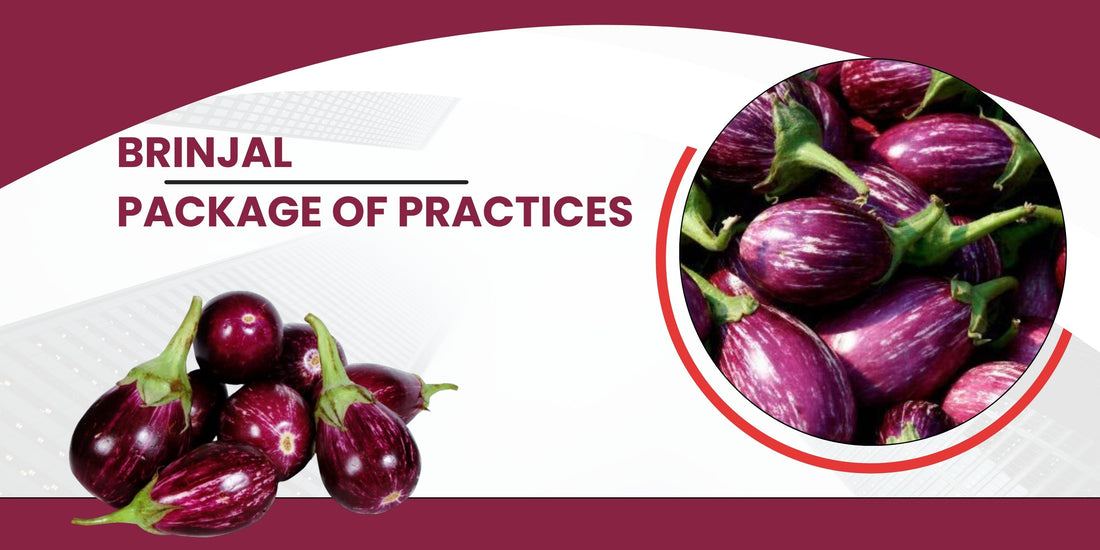
BRINJAL PACKAGE OF PRACTICES
Scientific name: Solanum melongena
Common Name : Egg plant/Vankaya
Introducion:
Brinjal is one the most common tropical vegetables grown in India. A large number of cultivars differing in size, shape and colour of fruits are grown in India. Immature fruits are used in curries and varieties of dishes are prepared out of brinjal. Fruits are moderate sources of vitamins and minerals like phosphorous, calcium and iron and nutritive value varies from variety to variety.
Soil Requirement:
Varying from light sandy to heavy clay, brinjal plants can be grown in all types of soil pH range of 6.5-7.5 with well drained soil and rich in organic matter is favourable. For early yield, light soils are preferred. But, for higher yield clay loam and silt loam soils are best suited.
Climate:
It is grown in warm season and needs a long warm growing season. It is very vulnerable to Frost.The most favourable temperature for its successful production on a daily basis is 13°c- 21°c.Temperature below 17°c can critically affect the growth of the crop. It can be favourably grown as a summer or rainy season crop and can grow at a height of 1200m above the sea level.
Land preparation:
Brinjal is a hardy crop and cultivated under a wide range of soils. Soil should be prepared to a fine tilth by 2-3 ploughings. FYM should be incorporated in soil at the time of final ploughing. Seedlings are transplanted in levelled land in plots of convenient size for irrigation.
Varieties:
-
Pusa purple long: 20-25 cm long purple fruits,favourable for summer and autumn planting,susceptible to bacterial wilt.
-
PH4: Bushy Plant, Pigmented stem, flesh light green, fruits are medium to long and thin.
- Pusa bhairav: Non-spiny, resistant to phomopsis fruit rot, glossy, 12-15cm long fruits.
- Pant Samrat: Tall vigorous plants, young leaves publish green, tolerant to shoot and fruit borer, released by UP state variety release committee in 1983 and by the central vriety release committee in 1984.
Season:
- It grows in plain over the year but it is best grown in Rabi season.
- In rainy season it is grown in the month of June-July.
- In Winter Season it is grown in the month of October-November.
- In Summer season it is grown in the month of February-March.
Seed Rate:
- For one hectare of land on an average 370-500gm seed is required for seedlings.
- Varities-400gms/ha and Hybrids-200gms/ha
Spacing:
- Spacing relies upon the type of grown variety and the planting season
- Usually the long fruited varieties are implanted at 60 x 45cm, round varieties at 75 x 60cm and high yielding varieties at 90 x90cm spacing.
- In case of heavy soils seedlings transplanted in light soils in furrows and in case of heavy soils on side of the ridges.
- 3-4 days preceding transplanting pre-soaking irrigation is given.
- During the time of transplanting seedlings should be dipped in Bavistin (2g/litre of water) solution.
- Preferable time of transplanting is evening.
Seed Treatment:
To prevent seed and soil borne infection of fungal diseases seeds should be treated with Trichoderma viridae / T. harzianum @ 2g /100 g of seeds.Or seeds can be treated with (Carbendazim 1.0g + Thiram 1.5g)/ kg of seeds.
Sowing:
Seeds are sown in nursery bed and transplanted to main field after four weeks when it is 8-10cm tall. Depending on growth of varieties and seasons of cultivation, 300-500g seeds are required for one hectare of planting.
Nursery and Bed Preparation for Brinjal Seedlings:
Raised beds should be prepared (7-7.5)(1.2- 1.5)(10-15). Seeds should be covered properly with FYM and Soil mixture. To avoid fungal diseases, seeds should be treated with captan and thiram @ 2kg/kg of seed. About 250-375 g of seeds is enough to cover one hectare of land with 30,000 to 45,000 seedlings. The seedlings can be transplanted in about 4-5 weeks.
Transplanting Seedlings:
Seedlings are ready for transplanting within 4-5 weeks. Harden the seedlings by withholding irrigation. Without any injury to the roots, uproot the seedlings carefully. Transplanting must be done followed by irrigation, and spacing depends upon the type of soil and its fertility. In general, (75*75) cm spacing can be kept.
Nutrient Management:
- The dose of fertilizer depends upon the fertility of soil and the amount of organic manure is applied to the crop. 15-10 tons of decomposed FYM is integrated into the soil.
- For optimum yield, application of 150kg N , 100Kg P2O5 and 50Kg K2O is recommended.
- At the time of Planting half dose of N and full dose of P and K is given.
- The half of N is given in equal 3 split doses.
- One and a half month after transplanting first split dose is given
- One month after the first application second dose is given.
- The final is given three and a half month after transplanting.
Water Management:
Timely irrigation is essential especially for fruit set and development. The irrigation is required at every third /4th day during summer while in winter, it should be 7-8 days interval. For row planted crop, drip irrigation is advantageous and fertilizer can be supplied through drip irrigation.
Weed Management:
It is essential to keep the field free of weeds especially at initial stages of crop growth and usually done by 2-3 light hoeing or earthing up. This facilitates better aeration to root system and gives support to plants.
Plant protection:
- 1.Fruit and Shoot borer:
- Scientific name: Leucinodes orbonalis.
Symptoms of damage:
|
Identification of pest:
|
Management:
- Remove the affected terminal shoot showing boreholes.
- Remove the affected fruits and destroy.
- Avoid continuous cropping of brinjal crop
- Grow the varieties with long and narrow fruits in endemic areas
- Install pheromone trap@12/ha
- Encourage the activity of larval parasitoids: Pristomerus testaceus, Cremastus flavoorbitalis
- Avoid use of synthetic pyrethroids
- Avoid using insecticides at the time of fruit maturation and harvest
- Neem seed kernel extract (NSKE) 5 % or
- Spray Neem Seed Kernel Extract 5 % or any one of the following chemicals like Azadirachtin,Dimethoate, Emamectin benzoate starting from one month after planting at 15 days interval.
- For effective control of borers, use Biopesticide “ LARVEX”@250ml/acre.
2. Brown plant hopper:
Scientific name: Cestius phycitis
Symptoms of damage:
- Reduction in size of leaves
- Shortened petioles
- Excessive growth of branches general stunting of plants
- Conversion of floral parts into leafy structures
- Plants become bushy
- Fruiting is rare
- Vector of little leaf of brinjal.
Identification of pest:
-
Adult: Small light brown leaf hopper
Management:
- Remove infected plants and destroy them
- Before transplantation dip the seedlings in 0.2% carbofuran 50 STD solution (control insect vectors)
- Spray with dimethoate 0.3%
- For effective control of leaf hopper use, Biopesticide “Dr.ELIMINATOR”@250 ML/acre.
Disease Management:
1.Damping off: Pythium spp, Phytophthora parasitica, Rhizoctonia solani and Sclerotium rolfsii.
Symptom:
- Sudden collapsing of the seed lings occur in the seed bed.
- The seedlings are attacked at the collar region and the attacked seedlings are toppled down.
- The disease spreads through fungi present in the soil. The disease spreads through fungi present in the soil.
Management:
- Treat the seeds with Trichoderma asperellum @ 4 g / kg or Pseudomonas fluorescens @ 10 g /kg of seeds 24 hours before sowing.
- Apply P. fluorescens to soil @ 2.5 kg/ha with 50 kg of FYM.
- Avoid stagnation of water. Drench with copper oxychloride at 2.5 g/l @ 4 l/sq.m.
- Intercrop with marigold at 4:1 ratio. Apply Pseudomonas fluorescens @ 10g/m2 for nematodes and damping off disease complex.
- The disease can be controlled by seed treatment with agrosan@2gm/kg of seed.
- Tobacco mosaic virus (TMV)
Symptoms:
- Mosaic mottling of leaves and stunting of plants are the characteristic symptoms of potato virus Y Mosaic symptoms are mild in early stages but later become severe.
- Infected leaves are deformed, small and leathery. Very few fruits are produced on infected plants.
- The important symptom produced by tobacco mosaic virus is conspicuous mottling of leaves.
- Leaves also develop blisters in advanced cases. Severely infected leaves become small and misshapen. Plants infected early remain stunted.
- PVY is easily sap transmitted.
- It is transmitted in the field through aphids, Aphis gossypii and Myzus persicae and perpetuates on weed hosts like Solanum nigrum and S.xanthocarpum.
- TMV is transmitted by sap, contaminated implements and clothes, soil debris and hands of labour.
- It can perpetuate on many cultivated plants like cucurbits, legumes, pepper, tobacco, tomato and weed hosts. The virus survives in plant debris in soil.
Management:
- Destroy all weeds and avoid planting cucumber, pepper, tobacco, tomato near brinjal seed beds and field.
- Spray insecticides like Dimethoate 2 ml/litre or Metasystox 1 ml/litre of water to control the insect vectors.
Harvesting & Yield:
Harvest can be done 55-60 days after transplanting. Fruits are harvested at tender stage at 4-5 days intervals.
Varieties: 25 to 30 t/ha
Hybrids: 45-50 t/ha
